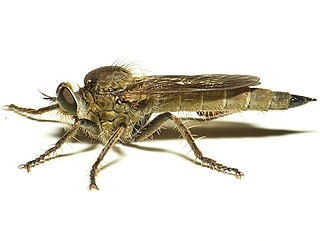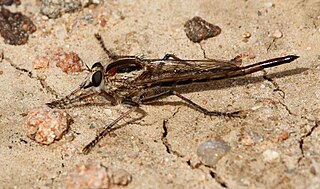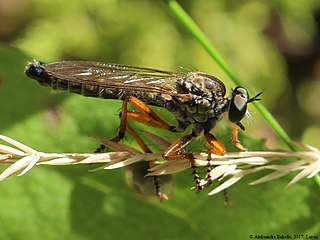
Amber is fossilized tree resin that has been appreciated for its color and natural beauty since Neolithic times. Much valued from antiquity to the present as a gemstone, amber is made into a variety of decorative objects. Amber is used in jewelry and has been used as a healing agent in folk medicine.

Bees are winged insects closely related to wasps and ants, known for their roles in pollination and, in the case of the best-known bee species, the western honey bee, for producing honey. Bees are a monophyletic lineage within the superfamily Apoidea. They are currently considered a clade, called Anthophila. There are over 20,000 known species of bees in seven recognized biological families. Some species – including honey bees, bumblebees, and stingless bees – live socially in colonies while most species (>90%) – including mason bees, carpenter bees, leafcutter bees, and sweat bees – are solitary.

Mosquitoes, the Culicidae, are a family of small flies consisting of 3,600 species. The word mosquito is Spanish and Portuguese for little fly. Mosquitoes have a slender segmented body, one pair of wings, three pairs of long hair-like legs, and specialized, highly elongated, piercing-sucking mouthparts. All mosquitoes drink nectar from flowers; females of some species have in addition adapted to drink blood. Evolutionary biologists view mosquitoes as micropredators, small animals that parasitise larger ones by drinking their blood without immediately killing them. Medical parasitologists view mosquitoes instead as vectors of disease, carrying protozoan parasites or bacterial or viral pathogens from one host to another.

Flies are insects of the order Diptera, the name being derived from the Greek δι- di- "two", and πτερόν pteron "wing". Insects of this order use only a single pair of wings to fly, the hindwings having evolved into advanced mechanosensory organs known as halteres, which act as high-speed sensors of rotational movement and allow dipterans to perform advanced aerobatics. Diptera is a large order containing an estimated 1,000,000 species including horse-flies, crane flies, hoverflies, mosquitoes and others, although only about 125,000 species have been described.

A crane fly is any member of the dipteran superfamily Tipuloidea, which contains the living families Cylindrotomidae, Limoniidae, Pediciidae and Tipulidae, as well as several extinct families. "Winter crane flies", members of the family Trichoceridae, are sufficiently different from the typical crane flies of Tipuloidea to be excluded from the superfamily Tipuloidea, and are placed as their sister group within Tipulomorpha.

The National Museum of Natural History (NMNH) is a natural history museum administered by the Smithsonian Institution, located on the National Mall in Washington, D.C., United States. It has free admission and is open 364 days a year. With 4.4 million visitors in 2023, it was the second most-visited museum in the United States.

The Asiloidea comprise a very large superfamily insects in the order Diptera, the true flies. It has a cosmopolitan distribution, occurring worldwide. It includes the family Bombyliidae, the bee flies, which are parasitoids, and the Asilidae, the robber flies, which are predators of other insects.

The Asilidae are the robber fly family, also called assassin flies. They are powerfully built, bristly flies with a short, stout proboscis enclosing the sharp, sucking hypopharynx. The name "robber flies" reflects their expert predatory habits; they feed mainly or exclusively on other insects and, as a rule, they wait in ambush and catch their prey in flight.

The Tanypezidae, known as the “stretched-foot flies”, are small family of acalyptrate Diptera. The 28 species are found mostly in the New World, divided between two genera: Tanypeza is found in North America, with the type species extending into the Palaearctic, and Neotanypeza is neotropical in distribution and includes one species known only from Dominican amber from 17 to 20 million years ago, N. dominicana Lonsdale & Apigian. This distribution contrasts that of its sister family, the Strongylophthalmyiidae, which is mostly East Asian in distribution.

Asilinae is a large subfamily of flies in the family Asilidae, the robber flies and assassin flies. It includes over 180 genera.

Machimus is a genus of flies in the family Asilidae, the robber flies and assassin flies. They can be found nearly worldwide, except in Australia and New Zealand. Most are native to the Palearctic realm and southern Asia.
Ironomyiidae is a small family of flies in the order Diptera. Historically, they had been included in the family Platypezidae, and includes three extant species within the single extant genus Ironomyia endemic to Australia and a number of extinct fossil genera from North America and Asia extending back to the Early Cretaceous.

Gembone, also known as gem bone, agatized dinosaur bone, or dinogem, is mineralized bone, often dinosaur bone, which occurs when minerals from groundwater are deposited within the bones. It is one of five gemstones created from organisms. Minerals replacing organic materials in gembone include iron minerals such as hematite, marcasite, and pyrite, and silica in cryptocrystalline form in agate and jasper, or as the amorphous mineraloid opal. Aside from their use in jewelry, scientists can use this type of specimen to perform research into the anatomic structure of ancient species.

Vetufebrus is an extinct genus of haemospororida in the family Plasmodiidae. At the time of its description the new genus comprised a single species Vetufebrus ovatus known from a single Miocene Dominican amber fossil found on Hispaniola. V. ovatus was vectored by Enischnomyia stegosoma, the first fossil streblid bat fly described from a fossil, and the only member of the subfamily Nycterophiliinae described from Hispaniola. V. ovatus is the first instance of a Streblidae bat fly as a host for a malarial parasite.

New Jersey Amber, sometimes called Raritan amber, is amber found in the Raritan and Magothy Formations of the Central Atlantic (Eastern) coast of the United States. It is dated to the Late Cretaceous, Turonian age, based on pollen analysis of the host formations. It has been known since the 19th century, with several of the old clay-pit sites now producing many specimens for study. It has yielded a number of organism fossils, including fungi, plants, tardigrades, insects and feathers. The first identified Cretaceous age ant was described from a fossil found in New Jersey in 1966.

Alcimus is a genus of flies in the family Asilidae, the robber flies and assassin flies. There are about 26 species which are native to the Afrotropics.

Holcocephala calva is a species of robber fly in the family Asilidae.

Neomochtherus pallipes, the Devon red-legged robber fly, is a species of robber fly in the family Asilidae.
Machimus elegans is a species of fly in the family Asilidae, the robber flies and assassin flies. It is found in the Near East.

















